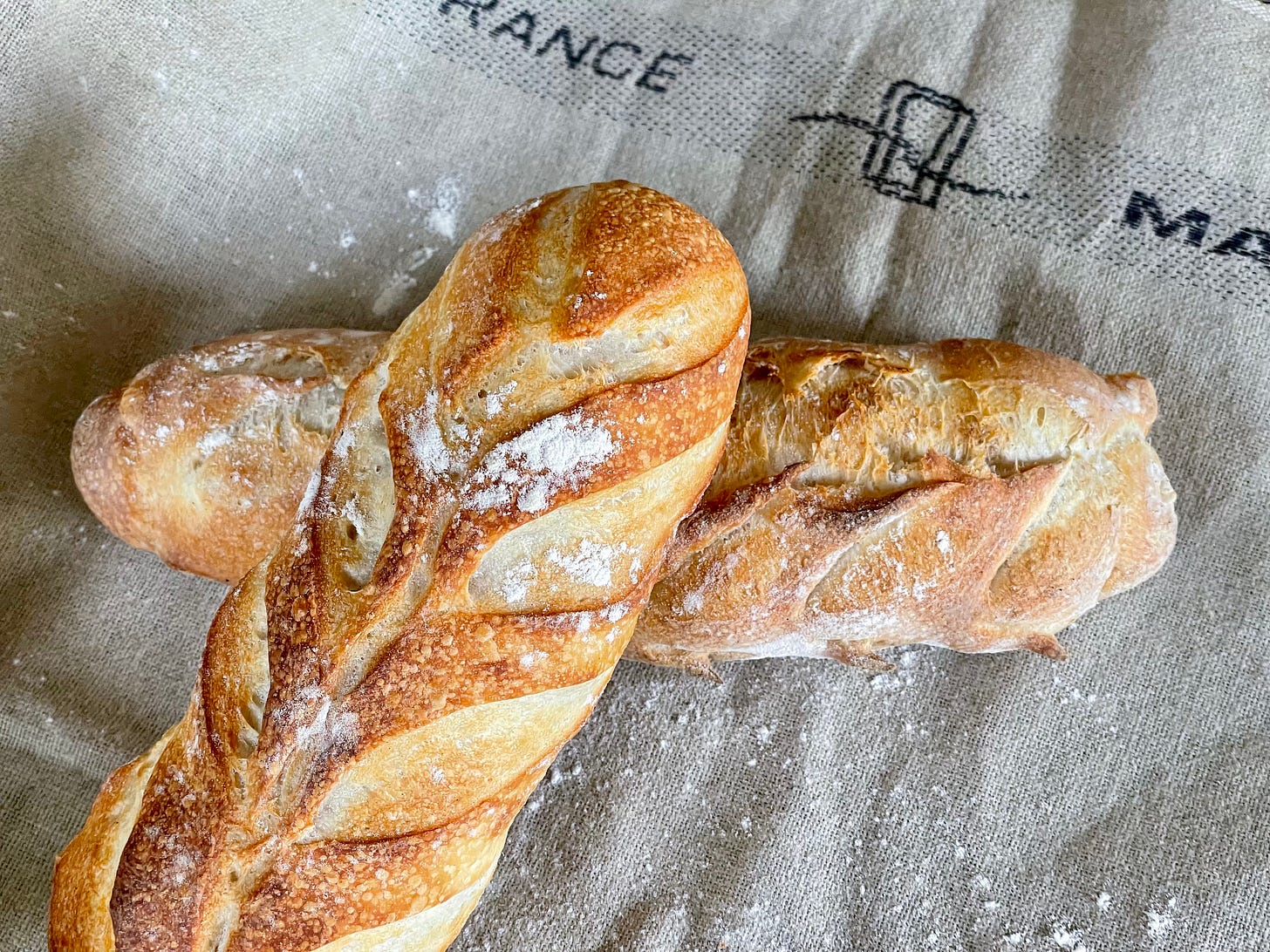Wild Lion*esses Pride is a space for honest reflections and conversations that matter. Reflections on trauma healing, authenticity, and personal growth—grounded in mindfulness and self-compassion. If you connect with biographical essays that explore the complexity of identity and the journey toward wholeness, this space is for you. and would like to show your support, please consider becoming a valued patron for only $5 a month or 50$ a year. Or a “Buy me a coffee” tip would be very generous. Thank you! 💚
There’s no real German bakery left in my town.
Not one where a baker still rises before dawn, where dough ferments slowly, where crust cracks open with meaning.
The last craft bakery closed its doors a few years ago. Before that, they held on with thinning shelves and tired eyes. Now, all we have are chain stores or supermarkets—bread that tastes like wet cardboard by nightfall, rolls that collapse under the weight of butter.
And the price? It keeps climbing. Not because the quality’s gone up. Quite the opposite.
That’s when I began to bake.
Not because I dreamed of sourdough starters or rustic boules. I simply missed bread. Real bread. The kind Germany once knew how to make in its sleep. The kind we built our culture on.
Because bread isn’t just food here. It’s a Grundnahrungsmittel—a foundational food. Our everyday staple. Our anchor.
At least, it used to be.
Back then, every village had its own rhythm of crust and crumb. Roggenmischbrot was the weekday workhorse—dense, dark, sour with life. Rolls came in a dozen shapes, each with its own tradition: Doppelwecken, Kaiserbrötchen, Mohnsemmel, Schrippen, Knauzenweck, Laugengebäck. You knew where someone came from by the roll in their hand.
In the South, rolls wore deep creases and shone with egg wash. In Berlin, Schrippen came light, crisp, unassuming. Go further west, and the Brötchen thickened, hearty and rustic. The flour changed with the soil. The crust told of ovens still fired with wood. The dough bore fingerprints of local custom.
Bread told stories. Quiet ones.
I remember one kind of story very clearly. It came on those rare Saturdays in my childhood when school didn’t call and the house stayed quiet just a little longer. Around 9:30, my father would take me along on our very own Brötchen-Tour.
We’d start at the bakery just across the street for their perfect Baguette rolls. Then we’d drive into town, stopping next at the place known for their Danish rolls—fluffy, layered things reminiscent of croissants but firmly rooted in German tradition. From there, it was on to the smallest and most cherished of our town’s nine craft bakeries: a tiny shop with legendary Dampf-Brötchen. Steam-Rolls. There was always a queue outside on Saturdays, waiting to squeeze into the warm scent of that narrow doorway.
We’d loop around the west side of the city center, making selective stops at favored spots, skipping the ones that had lost our loyalty. One place had the best Schlesische Brötchen, double rolls with a pull-apart center. Another offered our beloved Mohn- and Körnerbrötchen, poppyseed and grain-crusted rolls that rounded out our bounty.
That assortment kept us well-stocked for our slow Saturday breakfast, and for Sunday’s late brunch—a two-to-three hour affair of reading, sipping, chatting. Before I’d be sent to keep pace on a long hike through the hills and forests around town. That part I could have done without.
Still, that Brötchen-Tour was sacred. A map of tastes, textures, and loyalties. A living archive of what local baking once meant.
And just once a year, bread whispered louder. Around Easter, it stepped into shape: twisted Brezeln, braided Zöpfe, sun-shaped loaves echoing the Sonnenlaufbogen from pre-Christian times. These Gebildbrote—formed breads—spoke of spring, of hope, of returning light.
They still do, if you know how to look.
German Bread Tradition
At the Europäisches Brotmuseum in Ebergötzen, a small village about 30 minutes from my hometown of Einbeck, they still teach children how to braid a Zopf or twist a Sonnenrad, while the oven does its quiet work in the background. These breads weren’t always sweet. They weren’t cake in disguise. They were offerings. Symbols. Stories we shaped with our hands.
Bread and rolls hold a significant place in German fairy tales, symbolizing sustenance, tradition, and sometimes even a sense of hope or escape.
In tales collected by the Brothers Grimm, such as Hansel and Gretel, bread becomes a lifeline. The children use breadcrumbs to mark their path in the forest, but when birds eat the trail, it reflects the fragility of their survival. The act of eating or sharing bread often carries deeper meaning, symbolizing family bonds, scarcity, or even the potential for transformation.
Wilhelm Busch, who lived both in Ebergötzen and in the small village of Lüthorst six miles from my hometown, also embraced food symbolism in his work.
Though more known for his humorous, satirical illustrations and poems, Busch’s portrayal of daily life often brought bread and rolls into the spotlight, reflecting their role in the rural, working-class communities of northern Germany. In the context of his stories, food was not just nourishment, but also a reminder of the small joys and simple pleasures that connected characters to the land and to each other.
In these tales, bread and rolls are more than just food—they are markers of survival, connection, and the cyclical nature of life itself.
Whether in the dark woods or rural villages, they are the sustenance that ties us to both our families and our cultural heritage.
I don’t remember these traditions from my own childhood. They weren’t part of our daily life. And now, with real bread disappearing from our towns, they feel even further away. But there’s a longing. Not just for taste, but for connection. For the feel of dough under my palms. For the slowness it demands.
For the why.
Experimenting just because…
So I started to bake. First out of necessity, then out of curiosity, now out of something closer to devotion.
I wanted crust that spoke of patience. Crumb that told me how the dough had lived. And I wanted to taste grain again—not just air puffed into shape.
Lately, I’ve let myself experiment. I’ve taken a liking to French pain au levain, especially in the style of Poilâne. That dark, round miche. Strong. Subtle. Honest. It doesn’t try to be liked. It just is. I attribute my understanding of this bread, and the recipe I will share, to the MasterClass course taught by Apollonia Poilâne, CEO of the esteemed Parisian bakery, which details their philosophy and time-honored techniques for rustic French breads.
My version is rougher. More rustic. I use German flour—a mix of Type 550 bread flour, 1050 whole wheat and a bit of rye. Otherwise I follow her recipe, which does take as long as it takes. I shape a boule and bake it in my french “doux feu” Dutch Oven to create conditions similiar to those in a big wood fired stone oven. There’s too much rushing elsewhere in life.
What I love about this loaf isn’t just the chew or the crust. It’s what it teaches me about enough. About time. About autonomy. About the fact that I don’t need to accept what these systems hand me.
Because that’s the other part of the story.
These systems that replaced the craft bakery with wrapped industrial loaves rely on us forgetting.
They rely on convenience, repetition, and disconnection. They can only exist when we hand over our time, our hands, our trust. The mindset that sustains them is the same one that disconnects people from land, from labor, from community. From themselves.
I saw this mindset early. At school. At work. In the expectations placed on me as a child, and again as an adult. I saw how these systems ask you to trade presence for productivity. How they reward compliance and wear down resistance through exhaustion. They condition us to forget what’s real.
And yet, even now, I believe this: the moment I step back into the kitchen, I hold a choice. I can knead my way back into connection. Into agency. Into knowing what enough feels like on my tongue. I can taste what it means to be present.
This isn’t about nostalgia. It’s not about “going back.” It’s about shifting perspective. About choosing where I put my attention and energy. About making space to notice the difference between bread that nourishes and bread that fills a shelf.
You don’t need to bake your own bread to make that shift.
You only need to notice what you’ve been taught to accept—and ask yourself whether it truly serves you.
I did. And it changed everything.
This choice—to stop accepting and start noticing—began also with bread. Yet it reaches far beyond the kitchen. What we accept without reflection builds the scaffolding for systems that do not serve us. And those systems endure precisely because we’re trained not to question them. They dress themselves in efficiency, price tags, and the promise of ease, while quietly stripping away connection, quality, and care.
When I began baking, I didn’t yet have words for what I was reclaiming. I only knew I wanted to eat something real. Now I see it more clearly: this is about reclaiming my power to choose. To ask, "What have I accepted?" and then decide whether it belongs in my life.
That’s the shift. Not a revolution, not a grand gesture. Just this: learning how to notice what you accept—and choosing what truly serves you.
Paid Subcribers can download my full 7 page detailed Poilâne-Style Wheat Loaf (Miche) Recipe below or in my
Bringing you these recipes and sharing the culinary stories behind them is a true passion of mine.
Each twist, tweak, and taste test comes with the joy of creativity—and yes, a little bit of cost, too. If this recipe resonated with you and added a touch of nostalgia or delight to your day, I’d be incredibly grateful if you’d consider leaving a tip. Or, better yet, indulge in a monthly or yearly subscription to support this publication.
Your generosity helps keep these flavors alive and ensures I can continue exploring, experimenting, and sharing them with you.
Listen to this episode with a 7-day free trial
Subscribe to Wild Lion*esses Pride by Jay to listen to this post and get 7 days of free access to the full post archives.


















